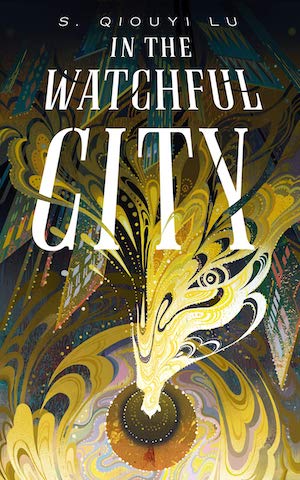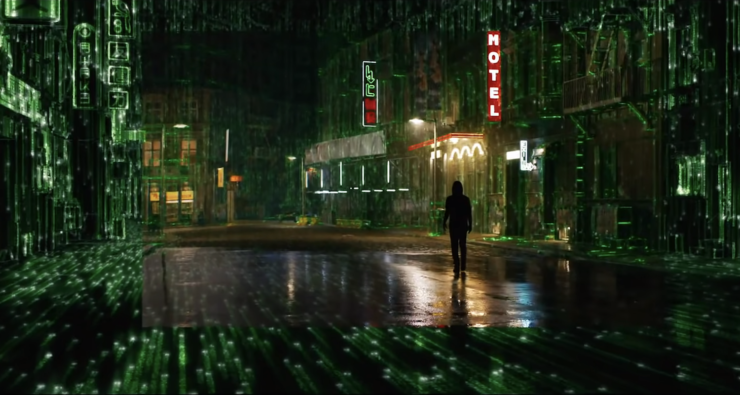This is 2021. And as I write this, 4,000 people have married their virtual assistants, luxury fashion brands are making millions auctioning off virtual clothing, and Harvard psychiatrists have issued a plea for advertisers to please restrain themselves from hacking people’s dreams.
We live in a cyberpunk world.
The fact that reality is increasingly, unabashedly, cyberpunk is one of the two prevailing narratives around this strange and provocative genre. The second is, of course, that ‘cyberpunk is dead’. It flared up in the 1980s and was gone by the 1990s. A genre that supposedly started, and ended, with Mirrorshades.
These two narratives—life is cyberpunk and cyberpunk is dead—are not inherently contradictory. The challenge with any form of science fiction is out-racing the exponentially increasing weirdness of the world around us. Relevance today is obsolescence tomorrow, and cyberpunk, with its grounded, near-future focus, is particularly susceptible to the latter. Cyberpunk fiction is dead because reality overtook it.
Or so they would have you believe.
What this tidy conclusion ignores is the practical fact that cyberpunk is, was, and always has been thriving. In 2021 we saw a particularly impressive resurgence of cyberpunk themed media, headlined by the biggest game of the year (Cyberpunk 2077) and potentially its biggest film (The Matrix Resurrections). We also saw major TV pick-ups like William Gibson’s The Peripheral and new series of the Westworld and Black Mirror; Cowboy Bebop and Outside the Wire. A foxy Swedish tabletop RPG was backed with 4000% funding on Kickstarter. We can drink cyberpunk-themed energy drinks, in our cyberpunk chairs, playing cyberpunk games on our cyberpunk phones. While dressed like this.
For that matter, there’s even a heavy cyberpunk influence to 2021’s MCU properties: the bio-enhanced anti-globalisation rebels of Falcon & Winter Soldier, the neon ninjas of Shang-Chi, or the lucid culture hacking of WandaVision. You don’t get more mainstream than Marvel.
And that’s not counting the plethora of other cyberpunk comics, artists, games, tarot decks(!), or fashion brands. Cyberpunk is not merely a label for describing the more disturbing aspects of reality. As an aesthetic, a theme, and a mode of escapism, the genre continues to thrive in all forms of creative media.
Buy the Book


In the Watchful City
All (other) forms, that is. But in 2021, we saw the world of publishing catch up, with several impressive, overtly cyberpunk, releases.
Cyberpunk stories, for example, proliferated across short fiction outlets. Nalo Hopkinson’s “Clap Back” (Amazon Originals) is a stand-alone short piece about cultural appropriation, racism and rebellion; it straddles the line between hilarious and tragic—a heroine that’s easy to cheer for, in a world that’s unpleasantly familiar. Arthur Liu’s “The Life Cycle of a Cyber Bar” (Future Science Fiction) is classic-with-a-twist, bringing to life the evocative (and strangely poignant) atmosphere of the titular setting. Ken McGrath’s “Hunting Warbirds” (HyphenPunk) is more familiar fare—an action-packed heist in an unequivocally cyberpunk setting. Sam J. Miller’s “Feral Arcade Children of the American Northeast” (Southwest Review) weaponises nostalgia, bringing to life the misbegotten dark-side of a ‘more innocent time’. Although ultimately empowering, it punctures our myths of a 1980s childhood, far more Lost Boys than Ready Player One. VH Ncube’s “The Diviner” (Omenana) also uses technology as a way to explore our self-created mythologies. The titular machine connects its users to their ancestral pasts: a way of learning, perhaps, but also so much more. What if it doesn’t actually work? Does that matter?
Cyberpunk has not actually been a literary desert since the 1980s, largely due to the efforts of authors such as Bruce Sterling, Rudy Rucker and Pat Cadigan. They have—and continue to be—pillars of the genre, and all of them had new publications in 2021. Sterling’s Robot Artists and Black Swans, his new collection, shows that, although he’s shed the the ‘cyberpunk’ label, he maintains a firm grip on what makes incredible storytelling, packed with grand, and relevant, ideas. Rudy Rucker’s Juicy Ghosts is a reaction to the chaos of the US election. It is an absolute romp—combining Rucker’s patented ability to inject high-concept science into high-kicking action—and builds, at pace, to an extremely satisfying (and perhaps cathartic) payoff. Pat Cadigan’s Alien 3—The Unproduced Screenplay is exactly the sort of media-spanning, gonzo collaboration that has always underpinned the cyberpunk movement, with Cadigan novelising William Gibson’s (infamously unused) screenplay for Alien 3. The existence of this book is, in and of itself, good fun—the content even more so. Although I remain Alien 3’s predominant (and only remaining?) defender, even I can appreciate how good this book was, and wistfully dream of alternative cinematic realities.
Fabio Fernandes’ Love. An Archaelogy is perhaps the most ‘classic’ cyberpunk of all 2021’s releases. It is a collection of brilliant, experimental writings that play with both literature and science, and fluidly move from dystopian dreamscapes to savvy techno-thrillers to amusing cultural pastiche. John Shirley’s Stormland stretches cyberpunk into the contemporary concern of the ‘cli-fi’ thriller. Stormland is a politically-charged detective thriller set against a backdrop of catastrophic climate change.
On the anthology front, Cyberfunk! and Bright Neon Futures both showed how the field has stretched and grown since its origins in the mid-1980s. Cyberfunk! is an Afrofuturistic perspective on the genre, with its contributions ranging from classic heists to scathing satire. Bright Neon Futures also progresses the genre—taking the same aesthetic, and technological assumptions, but with a more optimistic view of human nature. Make Shift, the latest in MIT Press’s annual anthology series, continues to explore the near future—this time with a focus on change-making. Upshot is a digital-only anthology, looking at science fiction as prompted by financial concepts. Economic SF doesn’t sound wildly sexy, but these are provocative stories from world-class writers that look at the near future through a different lens.
Cyberpunk has always been about experimentation with form as well as content—it is a genre that bloomed as much out of post-modernism as it did techno-fantasy. Vauhini Vara’s “Ghosts” (Believer) is, in many ways, the perfect cyberpunk story. Vara uses the medium of technology to process her own loss; a powerful experiment in storytelling that is inherently science-fictional while still being grounded in humanity. Despite its use of AI, it is never ‘about’ technology: it is about grief. Similarly, qntm’s “Lena” (Self-published) was released as a digital-only piece of free fiction, taking the form of Wikipedia entry. Although more directly ‘about’ AI, “Lena”, like “Ghosts”, is ultimately about humanity—in this case, the Gothic tragedy of the first uploaded brain. Despite the deliberately dry Wikipedian language, it is heart-breaking, down to the “See also” links at the end.
Perhaps my favourite of the year’s cyberpunk releases: Erica Satifka’s debut collection, How to Get to Apocalypse and Other Disasters. Although billed apocalyptically, the stories are less ‘volcanic explosion’ and more ‘introspective examination of how we’re sliding inexorably down the wrong path’. (Well, except for the one about the sentient bomb.)
These are the apocalypses of automation and redundancy; social stratification and malignant ignorance. Satifka has an incredible—unparalleled, even—ability to pack each story filled with technological concepts and imaginative conceits. It is excellent world-building, with every element strange and wondrous, but all perfectly plausible and naturally woven. It is a wave of new ideas, but never once feels like an onslaught, because the stories themselves are character-driven; about deeply empathetic people in these recognisable, if unsettling, worlds. These are stories that are not only immediately relevant, but will stand the test of time. Science fiction—cyberpunk, even—at its finest.
2021 takes us further into our cyberpunk present. We live in a world of mega-corporations, conspiracy theories, and underground movements. Billionaires fly into space while the earth-bound battle a global pandemic. We have immersive virtual worlds, combat sports, and AI-generated celebrities. But cyberpunk has never been about an end-game: it has always been about the next step. Readers, gamers and movie-goers remain insatiably curious about what happens next; what’s around the next corner. Cyberpunk allows us to indulge that curiosity from the relative safety of our own imagination. That is, until it comes true.
Jared Shurin is the editor of The Djinn Falls in Love, The Outcast Hours, The Best of British Fantasy, and many other published and/or forthcoming works. He writes irregularly at raptorvelocity.com and continuously at @straycarnivore.










